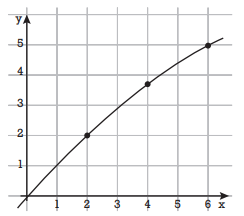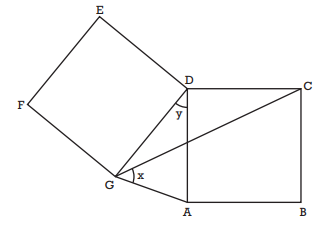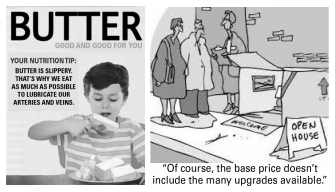Questões de Concurso Público ESPM 2019 para Vestibular 2020/1 - RS
Foram encontradas 79 questões
• Ana acertou 6 testes da parte A e 7 da parte B, obtendo a nota de 51 pontos. • Bia acertou 5 testes da parte A e 5 da parte B, obtendo a nota de 40 pontos. • Carla acertou 8 testes da parte A e 3 da parte B .
Podemos concluir que a nota obtida pela Carla foi de:

O valor de f(12) é:
Suponha que uma lâmpada incandescente cujo filamento tem coeficiente de temperatura α = 0,005°C–1 foi ligada a uma fonte de tensão constante e sua temperatura inicial era de 25°C. Podemos concluir que a potência dessa lâmpada ficará reduzida à metade quando a temperatura do filamento atingir, aproximadamente:

A B C D E M = [300 240 450 180 400] N = [60 40 30 20 25]
Uma operação matricial que permite o cálculo da população total desse país é:
• Se não houvesse pessoas boas, o mundo não seria um bom lugar. • Se houvesse pessoas boas, o mundo seria um bom lugar. • O mundo seria um bom lugar se houvesse pessoas boas. • Existem pessoas boas ou o mundo não seria um bom lugar.
podemos afirmar que são logicamente verdadeiras, em relação à premissa dada:


Assinale o tipo de malha quadriculada em que podemos escrever todos os números naturais consecutivos, a partir do 1, em suas quadrículas, de modo que dois números primos não ocupem casas contíguas:
A figura abaixo mostra dois exemplos diferentes de como distribuir 3 discos idênticos em 3 pinos.

O número total de maneiras de se fazer essa
distribuição é:
No polígono abaixo, todos os ângulos internos são retos, BC = CD = x e DE = EF.

Em relação à área desse polígono, podemos
afirmar que:
ABCD e DEFG são quadrados de mesma área. A medida do ângulo x é igual a:



Yesterday misunderstands what made the Beatles so popular
By Noah Berlatsky
The film Yesterday has an intriguing premise: What if the Beatles never existed? Unsuccessful, moderately talented singersongwriter Jack Malik wakes up one day and is the only one who remembers the Beatles’ songs. Suddenly he can pose as the creator of the greatest music ever written. As a result, he quickly becomes a worldrenowned superstar.
Jack is successful because the Beatles’ songs, removed from their original context, still maintain the universal, instant appeal that has canonized them in our non-fictional world, offscreen. Label execs, other musicians, and huge numbers of fans are all won over by “Jack’s” music; Even decades after the Soviet Union disintegrated, “Back in the USSR” still rocks people’s world.
But would “Back in the USSR” really be an automatic, surefire hit if it were released today, into a music scene whose interests have evolved far beyond the Beatles? Is quality in the arts so transcendent that it can overcome all differences of era, culture, and happenstance? Is music a meritocracy — an art form that privileges natural talent over everything else?
There’s good reason to believe that the answer to all three of those questions is no. Wonderful songs aren’t always hits; talented musicians don’t always achieve success commensurate with their abilities. And sometimes a twist of fate lands the less talented in a position to reap massive rewards.
We tend to expect that good things don’t always come to the most deserving people. Sometimes the most successful people get that way because they’re in the right place at the right time, or know the right people, or were even born into it. And art is no exception.
There’s research to back up the notion that fame and fortune come from more than pure talent. Sociologists Matthew Salganik of Princeton and Duncan Watts of Microsoft have conducted a number of studies to determine what makes a song popular. They discovered that when someone approaches a song knowing only that it’s popular and well-liked within the cultural mass, that person is more inclined to come away liking the song too. This can create a ripple effect, with songs becoming more and more popular because they already are popular. Salganik and Watts’s research suggests that the more visible something is the more highly regarded it is, and the more popular it is likely to become.
Social influence has a powerful effect on which songs become popular. As art is a form of communication we often share and experience socially, it makes sense that we like art that we believe will connect us to others.
Our instincts to spread what we like, and to like what others like, mean that what seem like small advantages for a song — perhaps a well-placed promo on Spotify, or appearing on the soundtrack of a Netflix show — can lead to a big chart presence. A good review at the right time or being used in a viral meme on a slow news day could help more people discover a song just out of happenstance. Songs that get an initial bump can ride that wave, so more people seek them out, buy them, and boost their popularity. This cycle can lead to one song, good or not, becoming a hit, while another disappears into obscurity.
The Beatles were very good by most qualitative metrics. But the band’s quantitative achievements don’t mean they are indisputably the most meritorious musicians of all time, or even of their day. More likely, the band also managed to be in the right place at the right time, on top of everything else.
Western racial inequalities also stymied many homegrown artists. Influential African American singers and girl groups like the Shirelles didn’t have much opportunity to turn their Billboard hits into widespread celebrity and lasting cultural recognition. Paul McCartney and John Lennon are household names, but there aren’t many casual music fans who know the name of the Shirelles’ lead singer, Shirley Owens.
The Beatles were white, male English speakers who were able to tour and didn’t die young. But they had other advantages as well. Perhaps most obviously, they were working in a genre that was broadly popular.
By contrast, today’s most popular music is split between contemporary hip-hop and dance music that relies on synthesizers, electronics, and myriad crossgenre references. Pure rock ’n’ roll, built on a simple four-person setup of guitar, bass, drums, and vocals, is no longer the dominant genre. ”If a Beatles song came out today, it would sound dated,” Charlie Harding, host of Vox’s Switched on Pop podcast, told me. “There are hardly any synthesizers. It’s all live drumming. Plus, so much of their music is blues-based, and blues-based music just isn’t popular right now.”
At their height, the Beatles famously pushed boundaries in the studio, creating psychedelic effects and soundscapes that no one at the time had ever heard before. But that’s old hat in 2019. You can do all of what the Beatles did and more in your room with a laptop, at least technically speaking.
Sure, it’s fun to think, as Yesterday does, that our love for the Beatles is universal, true, and incontrovertible. Where’s the harm in that?
The problem is that people often don’t see the myth of meritocracy as a myth; they really believe in it. And when they do, it can have some unfortunate effects. The myth of meritocracy can make us less willing to invest in the collective good.
If we convince ourselves that talented artists like the Beatles will be successful no matter what, we can also convince ourselves that we don’t really need to provide people with safety nets or resources. After all, the best will win out anyway. Why invest in school arts programs, or fund arts grants, if great musicians will be just fine on their own?
The Beatles made wonderful, undoubtedly influential art. But if Yesterday weren’t so hypnotized by the supposedly unmatchable quality of the Beatles’ music, it might be able to see that there are great songs being written by people like Jack Malik too. The film believes that songs like “Yesterday” are just so good, they would become mega-popular under any circumstances. And yet many people who think “Yesterday” is the best song ever have been inevitably swayed by the Beatles’ popularity and legacy, the song’s quality aside.
Maybe instead, the best song ever is one we haven’t heard yet; maybe it’s the one you’re going to write. Part of what happens when we abandon the myth of meritocracy is that we’re better able to see the merit all around us. And that gives everyone a greater chance at success.
(adapted from https://www.vox.com, Jun 29, 2019)

Yesterday misunderstands what made the Beatles so popular
By Noah Berlatsky
The film Yesterday has an intriguing premise: What if the Beatles never existed? Unsuccessful, moderately talented singersongwriter Jack Malik wakes up one day and is the only one who remembers the Beatles’ songs. Suddenly he can pose as the creator of the greatest music ever written. As a result, he quickly becomes a worldrenowned superstar.
Jack is successful because the Beatles’ songs, removed from their original context, still maintain the universal, instant appeal that has canonized them in our non-fictional world, offscreen. Label execs, other musicians, and huge numbers of fans are all won over by “Jack’s” music; Even decades after the Soviet Union disintegrated, “Back in the USSR” still rocks people’s world.
But would “Back in the USSR” really be an automatic, surefire hit if it were released today, into a music scene whose interests have evolved far beyond the Beatles? Is quality in the arts so transcendent that it can overcome all differences of era, culture, and happenstance? Is music a meritocracy — an art form that privileges natural talent over everything else?
There’s good reason to believe that the answer to all three of those questions is no. Wonderful songs aren’t always hits; talented musicians don’t always achieve success commensurate with their abilities. And sometimes a twist of fate lands the less talented in a position to reap massive rewards.
We tend to expect that good things don’t always come to the most deserving people. Sometimes the most successful people get that way because they’re in the right place at the right time, or know the right people, or were even born into it. And art is no exception.
There’s research to back up the notion that fame and fortune come from more than pure talent. Sociologists Matthew Salganik of Princeton and Duncan Watts of Microsoft have conducted a number of studies to determine what makes a song popular. They discovered that when someone approaches a song knowing only that it’s popular and well-liked within the cultural mass, that person is more inclined to come away liking the song too. This can create a ripple effect, with songs becoming more and more popular because they already are popular. Salganik and Watts’s research suggests that the more visible something is the more highly regarded it is, and the more popular it is likely to become.
Social influence has a powerful effect on which songs become popular. As art is a form of communication we often share and experience socially, it makes sense that we like art that we believe will connect us to others.
Our instincts to spread what we like, and to like what others like, mean that what seem like small advantages for a song — perhaps a well-placed promo on Spotify, or appearing on the soundtrack of a Netflix show — can lead to a big chart presence. A good review at the right time or being used in a viral meme on a slow news day could help more people discover a song just out of happenstance. Songs that get an initial bump can ride that wave, so more people seek them out, buy them, and boost their popularity. This cycle can lead to one song, good or not, becoming a hit, while another disappears into obscurity.
The Beatles were very good by most qualitative metrics. But the band’s quantitative achievements don’t mean they are indisputably the most meritorious musicians of all time, or even of their day. More likely, the band also managed to be in the right place at the right time, on top of everything else.
Western racial inequalities also stymied many homegrown artists. Influential African American singers and girl groups like the Shirelles didn’t have much opportunity to turn their Billboard hits into widespread celebrity and lasting cultural recognition. Paul McCartney and John Lennon are household names, but there aren’t many casual music fans who know the name of the Shirelles’ lead singer, Shirley Owens.
The Beatles were white, male English speakers who were able to tour and didn’t die young. But they had other advantages as well. Perhaps most obviously, they were working in a genre that was broadly popular.
By contrast, today’s most popular music is split between contemporary hip-hop and dance music that relies on synthesizers, electronics, and myriad crossgenre references. Pure rock ’n’ roll, built on a simple four-person setup of guitar, bass, drums, and vocals, is no longer the dominant genre. ”If a Beatles song came out today, it would sound dated,” Charlie Harding, host of Vox’s Switched on Pop podcast, told me. “There are hardly any synthesizers. It’s all live drumming. Plus, so much of their music is blues-based, and blues-based music just isn’t popular right now.”
At their height, the Beatles famously pushed boundaries in the studio, creating psychedelic effects and soundscapes that no one at the time had ever heard before. But that’s old hat in 2019. You can do all of what the Beatles did and more in your room with a laptop, at least technically speaking.
Sure, it’s fun to think, as Yesterday does, that our love for the Beatles is universal, true, and incontrovertible. Where’s the harm in that?
The problem is that people often don’t see the myth of meritocracy as a myth; they really believe in it. And when they do, it can have some unfortunate effects. The myth of meritocracy can make us less willing to invest in the collective good.
If we convince ourselves that talented artists like the Beatles will be successful no matter what, we can also convince ourselves that we don’t really need to provide people with safety nets or resources. After all, the best will win out anyway. Why invest in school arts programs, or fund arts grants, if great musicians will be just fine on their own?
The Beatles made wonderful, undoubtedly influential art. But if Yesterday weren’t so hypnotized by the supposedly unmatchable quality of the Beatles’ music, it might be able to see that there are great songs being written by people like Jack Malik too. The film believes that songs like “Yesterday” are just so good, they would become mega-popular under any circumstances. And yet many people who think “Yesterday” is the best song ever have been inevitably swayed by the Beatles’ popularity and legacy, the song’s quality aside.
Maybe instead, the best song ever is one we haven’t heard yet; maybe it’s the one you’re going to write. Part of what happens when we abandon the myth of meritocracy is that we’re better able to see the merit all around us. And that gives everyone a greater chance at success.
(adapted from https://www.vox.com, Jun 29, 2019)
4 Types of Deceptive Advertising
By Apryl Duncan
Deceptive advertising is officially defined by the Federal Trade Commission (FTC) as “practices that have been found misleading or deceptive. Specific cases include false oral or written representations, misleading price claims, sales of hazardous or systematically defective products or services without adequate disclosures, failure to disclose information regarding pyramid sales, use of bait and switch techniques, failure to perform promised services, and failure to meet warranty obligations.

4 Types of Deceptive Advertising
By Apryl Duncan
Deceptive advertising is officially defined by the Federal Trade Commission (FTC) as “practices that have been found misleading or deceptive. Specific cases include false oral or written representations, misleading price claims, sales of hazardous or systematically defective products or services without adequate disclosures, failure to disclose information regarding pyramid sales, use of bait and switch techniques, failure to perform promised services, and failure to meet warranty obligations.

